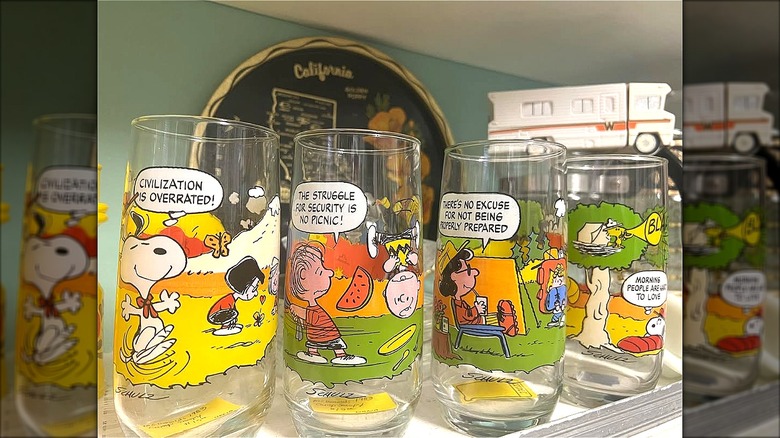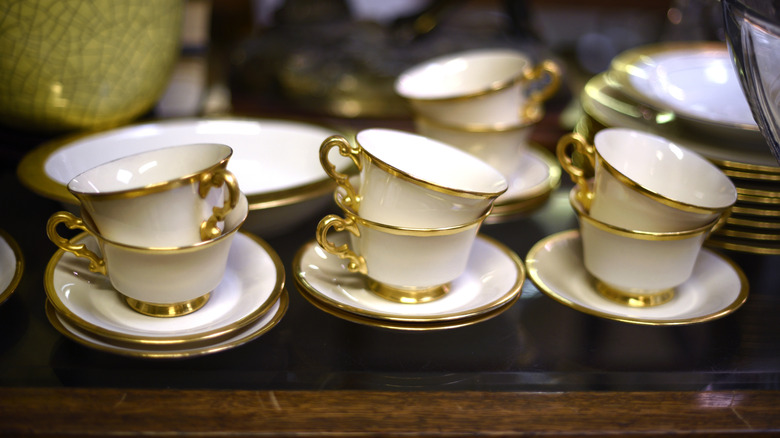Why You Should Avoid Bringing Vintage McDonald's Glass Cups Into Your Home
Vintage McDonald's collector glasses have the power to take their owner right back to childhood memories, like the Happy Meals enjoyed around family or the PlayPlace birthday parties shared with friends. But, while they're a great token of remembrance and source of nostalgia, they're best kept on the shelf and away from any mouth. This is because vintage McDonald's glasses like the Action Series Glasses with McDonaldland characters from 1977 or the Camp Snoopy Glasses from 1983 are likely to contain toxic heavy metals like lead and cadmium.
In fact, you don't even need to go that far back in time. As recently as 2010, the fast food chain had to recall a special "Shrek Forever After" glass collection because of the presence of cadmium in the paint. Lead and cadmium were common in homeware, used to make glazes shinier or colors brighter, until they were regulated in the U.S. in 1971 and phased out from then. That doesn't mean that glasses made after that date aren't dangerous, however.
Tamara Rubin, who runs the website Lead Safe Mama, tests vintage items using x-ray technology. In 2022, she found that the Grimace glass from the previously mentioned Action Series contained "extremely unsafe levels of lead and cadmium" (per Lead Safe Mama). Today, the legal maximum of lead in surface coatings is 90 parts per million, but this vintage McDonald's glass contained over 100 thousand. Other items like Camp Snoopy glasses and the Garfield "Use Your Friends Wisely" mug produced similar results.
The dangers of lead and cadmium
Most people aren't aware of the potential hazard that could be hiding in their thrifted glass and mug collection. Lead and cadmium can be devastating for the health of consumers and are both incredibly hard to detect. For one, it's not like they have any special smell or color that give them away, and, as controlled as the market may be today, vintage or secondhand items selling at thrift stores or places like eBay don't have to adhere to the same rules.
These substances are dangerous when they leach into food, drink, or even your hands, no matter how small the level of exposure may be. For children, who might reach for these colorful McDonald's glasses first, even exposure to the smallest amount of lead can be critical, resulting in developmental stunting, seizures, hearing loss, and loss of appetite, to name a few symptoms. In adults, low-level exposure over a prolonged period of time, as with drinking from contaminated glasses every day, can lead to cardiovascular and kidney diseases, as well as mood disorders, high blood pressure, fogginess, and reproductive issues. Lead poisoning is treatable, but if caught too late, it can provoke irrevocable damage, including death. The same is true for cadmium.
Why lead and cadmium are a problem in vintage tableware
The problem of lead and cadmium in vintage tableware is twofold. Yes, these toxic metals were a main ingredient in glaze and paint up until the 1970s, but as pieces age from heavy wear, the risk of leaching increases. Lead glaze was most commonly used on earthenware and porcelain to make pieces look smoother, create a shinier finish, and increase resistance to chips and cracks. High quality ceramics are less likely to leach as the high temperatures at which they're fired effectively sealed the lead. However, anything from acidic, hot liquids to harsh cleaning products or microwave use can corrode the seal and expose the user to nefarious quantities of lead. The same goes for cadmium, which is especially prevalent in brightly colored paint like yellow, red, and orange. As a rule of thumb, it's best to avoid using all colorful vintage ceramics and glassware. Unpainted, unglazed items are less dangerous, but caution is always advised.
Although it isn't exactly accessible, as home kits can be unreliable and lab tests can get pricey, you should always check your vintage glassware for lead and cadmium if you're set on using them. The safest choice, however, is to reserve them for decorative purposes or upcycle them into something like a beautiful DIY candle centerpiece. If you're a collector, some vintage McDonald's glasses can be worth upwards of $500, so keeping them safely stored for a rainy day isn't a bad idea, either.


